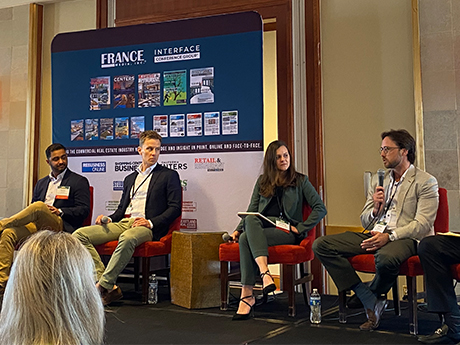By Taylor Williams
Industry professionals who hail from and work in San Antonio often describe the city’s economy and real estate scene as steady and healthy in a sort of unspectacular way.
Rarely does any commercial sector in San Antonio achieve the high highs and low lows of gateway coastal markets. Further, the market’s quiet consistency has come to stand out as its neighbor up the road, Austin, has exploded as a tech hub in the past decade, bringing with it fervent building booms that still can’t put a dent in the skyrocketing cost of living.
Yet this same quality that in years past caused major retailers and restaurants — and investors — to pass on San Antonio is now a primary force that attracts them to the Alamo City, at least according to some local industry experts. Some of these individuals elaborated on the trend at the inaugural InterFace San Antonio retail conference, which took place on April 4 at the Hilton Palacio Del Rio hotel.
Bethany Babcock, principal and co-owner of full-service firm Foresite Commercial Real Estate, was the first industry expert who addressed the market’s evolution in the post-COVID era.
“We noticed at the last couple trade shows we attended that San Antonio is on the radars of national tenants in a way that we haven’t seen in the past 20 years,” she said. “Retailers, when they looked at Texas, used to prioritize Dallas and Houston and eventually San Antonio. Now San Antonio has jumped some other markets due to the city’s slow and steady economic principles and fundamentals. Retailers have taken notice, and it makes this a very fun time to be in San Antonio.”
Price Onken, first vice president in CBRE’s San Antonio office, shared similar anecdotal evidence of how national retailers have changed their perception of the market over time.
“It used to be that as a broker, you’d call a tenant, trying to win their business and ask, ‘when are you coming to San Antonio?’” Onken recalled. “And we’d be fourth [on their list of Texas markets] at best. In the past, a retailer might come to San Antonio and do four to six deals over five years, which wasn’t really interesting to a lot of groups. The difference today lies in the growth of the market — there’s 12 to 14 submarkets that make sense for a lot of tenants to operate in.”
Onken added that for tenants with smaller physical requirements that serve residential neighborhoods, San Antonio makes sense due its prevalence of unanchored strip centers. “With good data, population growth and sales, we’ve been able to gain the attention of a lot of these users, and they can jump past Austin, which is a tough infill market that’s difficult to grow in.”
He also stated that many of these corporate users tend to target their San Antonio launches in conjunction with another market, oftentimes Houston. Nonetheless, San Antonio is unequivocally one of the “Big Four,” in terms of retailers’ key markets in Texas.
Babcock also noted that as construction of new retail space has stagnated throughout major markets in recent years, pushing vacancy down and rents up, retailers have come to appreciate San Antonio’s relatively affordable rents. Retail rents in San Antonio are also rising, but not to the extent of comparable markets, she said. National users with strong credit profiles that corporately guarantee their leases can more easily afford those rents compared to local mom-and-pop tenants, hence their growth in the market.
According to first-quarter 2024 data from CBRE, the average asking rent for retail space for San Antonio was $18.05 per square foot. That figure represents a 2.2 percent increase relative to the first quarter of 2023 — a very gradual and manageable increase that reflects the city’s broader economic identity.
For comparison, asking rents in Austin were $27.53 per square foot in the first quarter of 2024, according to CBRE. Dallas and Houston both clocked in at approximately $20 per square foot. In terms of vacancy, San Antonio held its own with the other trio of major Texas markets, recording a 4.3 percent rate in the first quarter of this year. Although that figure eclipses the 3.4 vacancy rate of Austin’s retail market, it is lower than those of Dallas (4.8 percent) and Houston (5.4 percent).
Aamil Sarfani, CEO of Sarfani Commercial Advisors, identified some other factors that have helped elevate San Antonio’s appeal to major retail and restaurant users. His analysis underscored the previously established theme of stability as the hallmark of the local economy.
“The economy here is incredibly diverse from an industry standpoint, so you don’t have the big ups and downs that you see other markets dealing with, such as Austin with tech and Houston with oil and gas,” he said. “The infrastructure and affordability of San Antonio are also big attractors. Also, San Antonio has gotten cooler over the past five years, and a lot of those cool concepts are starting to see San Antonio as a market in which they can grow. All of those things are making San Antonio attractive and a place that’s on the map for a lot of the big concepts out there.”


